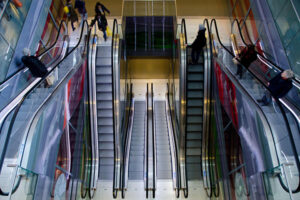While, quite some time ago, retail parks were rather unpopular, they have since developed into a highly successful asset class – including in Austria and Germany. They can be found on the outskirts of both large and small towns, in metropolitan regions, and in rural areas. “With regard to Austria, however, they have really made their presence known in the district capitals,” as Hannes Lindner, Managing Partner of Austrian consulting agency Standort + Markt, explains, based on in-house studies. “Their standing is particularly important there.” As a result, it comes as no surprise to Lindner that the proportion of retail parks in the Alpine republic has doubled in the last 10 years.
“Compared to Germany, Austrians spend more money in the retail sector. Consequently, retail parks in Austria thrive in much smaller areas as well,” says Angelus Bernreuther, Head of Investor Relations at Kaufland Deutschland. “Germany, on the other hand, is quite polycentric. The entry level is slightly higher there. Initially, Kaufland operated as a self-service department store, a kind of rural department store. That is why we consider rural areas to be growth regions. In addition, retail parks have always been “food-anchored”, which Bernreuther certainly takes into account as part of his retail park strategy. “We still have a lot of plans.”
There was general agreement among the panelists that the boom in retail parks, both in Germany and in Austria, has resulted in a veritable process of focus and increasing polarization among the various locations.
A Sustainable Asset Class
Just what makes retail parks so attractive to consumers, retailers, and developers alike? “First and foremost, the favorable ‘rent to sales ratio’ is of particular interest,” says Stefan Rutter, Real Estate Developer and Owner of the Rutter Real Estate Group. While rents and operating costs for shopping centers are much higher than those for retail parks, “similar to an Unimog, the retail park is one type of business that can operate on any terrain.” Henrike Waldburg, Head of Investment Management Retail at Union Investment takes a similar view: “Retail parks are symbols of stability. They constitute a sustainable asset class compared to other segments.”
Moreover, “Retail parks are cost-efficient, they are not overcrowded, and they are easily comprehensible for customers. All of the retail stores are positioned right alongside each other, which also makes shopping easier for consumers,” says Günther Helm, CEO of Müller Holding, about the advantages afforded by the retail property. Retailers mostly benefit from the flexibility potential that exists in terms of space design. The smallest Müller outlet measures just 76 sq m, while the largest is a lofty 4,400 sq m, which is also reflected in the chain’s product range. Depending on the location, the retailer offers between 1,800 and 300,000 items. According to the Müller boss, the ideal size of a store ranges from approximately 1,800 sq m to 2,000 sq m. “Retail parks are of great interest to us. However, not all of them are successful,” Helm admits. When selecting the right location, the retail chain pays particular attention to the catchment area, the purchasing power in the region, the infrastructure, and the competitive environment. Angelus Bernreuther, on the other hand, sees Kaufland as a footfall generator in the retail park sector and defines the ideal “neighbor” in this manner: “Anything that complements the concept of local supply.” In this context, the discounter-oriented segments that encompass theme worlds, fashion, drugstores, and sports are the primary areas of focus. The quality of the stay that a property offers is another focal point for Bernreuther.
Quality of stay and architecture are also of the utmost importance to Real Estate Developer Stefan Rutter. He and his team have been committed to creating “pleasant atmospheres” for their customers since the first retail park was developed by the Rutter Group some 20 years ago. “The traditional check-out area no longer exists. Well thought-out space concepts have become increasingly important and have a positive effect on emotional appeal,” Rutter is convinced. Even though this reduces developers’ margins due to the fact that construction costs have risen considerably and additional investments are often necessary, it is essential to ensure the future of retail parks. It is important to bear one thing in mind in this respect: “The simplicity of the concept should not be destroyed,” warns Rutter.
The Era Of Unadorned Spaces Is Over
A reinterpretation of the traditional check-out area is also being tested at Kaufland. “The one-stop shopping concept was initially at the forefront of our approach. Today, we refer to it as an ‘Open Mall’ concept,” Kaufland manager Bernreuther reveals. The corresponding rental spaces have increased in size, feature a common seating area, and are occupied by retail park-oriented tenants.
Gone are the days of unadorned, demand-oriented architectural spaces, which was unanimously agreed upon by all discussion participants. The food retail sector has recently contributed to this development. Innovative retailers, such as Edeka and Lidl in Germany as well as MPreis and Hofer in Austria, have impressed the public with their modern concepts, thereby increasing footfall and customer loyalty at retail parks. Generally speaking, the architectural versatility of retail parks also serves as an advantage when it comes to special-purpose properties. Henrike Waldburg of Union Investment: “Compared to shopping centers, upgrading is relatively easy. We are talking about low single-digit millions.” The advantage is clear: Attractive architectural concepts not only increase the length of stay and the pleasant atmosphere of a location, but they also make an indispensable contribution to the creation of identity.
The trend toward improved gastronomic offerings, which can be found in the shopping center industry, for instance, has, in the meantime, also fully permeated the retail park sector. Gastronomy is deliberately used as a means of “emotional stimulation” at selected locations. That trend is on the rise.
However, how resilient are retail parks to online competition? “That, of course, depends on the corresponding branch mix and how strongly e-commerce sales perform in those areas,” says Hannes Lindner. Angelus Bernreuther: “As a food retailer, I monitor the situation with both respect and calmness, and I have complete confidence in brick-and-mortar retailing.”






